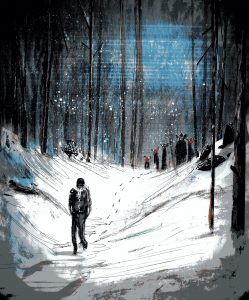An essay by Zoe Torres, as provided by Holly Schofield
Art by Luke Spooner
The footprints were as big as my snowshoe, the narrow heel a crisp outline, the impression not more than a couple of hours old.
The tracks beelined from the forest edge right through my campsite, growing more erratic as they disappeared on the far side between dark spruce trees hunched under winter burdens. I shuddered, picturing the clown stumbling through last night’s snowy darkness: hands flapping in the cold, grinning fiercely, a low hoot escaping from winter-roughened lips. With my heavy down sleeping bag pulled over my head, I hadn’t heard a sound, relying on the campfire to keep away predators.
I plodded over to where the tracks entered the clearing, slush sticking to my snowshoes. The sun had risen above the mountaintops, warm for February, warmer than all previous weather records.
A clump of coarse orange hair clung to a hemlock twig, sodden with mud. The email from the game warden had been accurate–the clowns had left hibernation early, the earliest yet, the unusually high temperatures triggering abnormal metabolic changes.
The troupe’s cave would be much farther up the mountain. I pictured melting ice dripping off the cave ceiling, streaking their greasepaint as they lay curled around one another like rats in a nest. With blank expressions and creaking joints, they’d unfold themselves, straighten their faded blouses on their too-lean frames, and honk softly. Then, they’d burst forth from the cave, one after another after another after another after another, bewildered by the bright sunshine, wanting to sate their terrible hunger.
What could one biologist do? I’d soon finish my dissertation on the wild clowns’ shrinking range, but there could be no future in coulrology. Since my study had begun, frown lines had etched an oval around my mouth.

A raven honked. I jumped and then made myself turn a deliberate circle, my overlapping tracks creating a daisy pattern in the snow. No wide white teeth gleamed, no broad half-moon eyes stared at me from the dim forest. The troupe should be far away, hunting until dawn.
To read the rest of this story, check out the Mad Scientist Journal: Spring 2018 collection.
Biologist Zoe Torres pioneered feral clown habitat degradation studies and was a leader in the field throughout her short career. She is also posthumously remembered for her vast collection of coulrine scat. One of her thigh bones is preserved at the Smithsonian, and close examination of the many teeth marks thereon will reward keen observers.
Holly Schofield travels through time at the rate of one second per second, oscillating between the alternate realities of city and country life. She hopes to save the world through science fiction and homegrown heritage tomatoes. For more of her work, including free and clownless stories, visit hollyschofield.wordpress.com.
Luke Spooner, a.k.a. ‘Carrion House,’ currently lives and works in the South of England. Having recently graduated from the University of Portsmouth with a first class degree, he is now a full time illustrator for just about any project that piques his interest. Despite regular forays into children’s books and fairy tales, his true love lies in anything macabre, melancholy, or dark in nature and essence. He believes that the job of putting someone else’s words into a visual form, to accompany and support their text, is a massive responsibility, as well as being something he truly treasures. You can visit his web site at www.carrionhouse.com.
“A Distant Honk” is © 2016 Holly Schofield
Art accompanying story is © 2018 Luke Spooner
This story originally appeared in Clowns: The Unlikely Coulrophobia Remix and Little Blue Marble.
Follow us online: